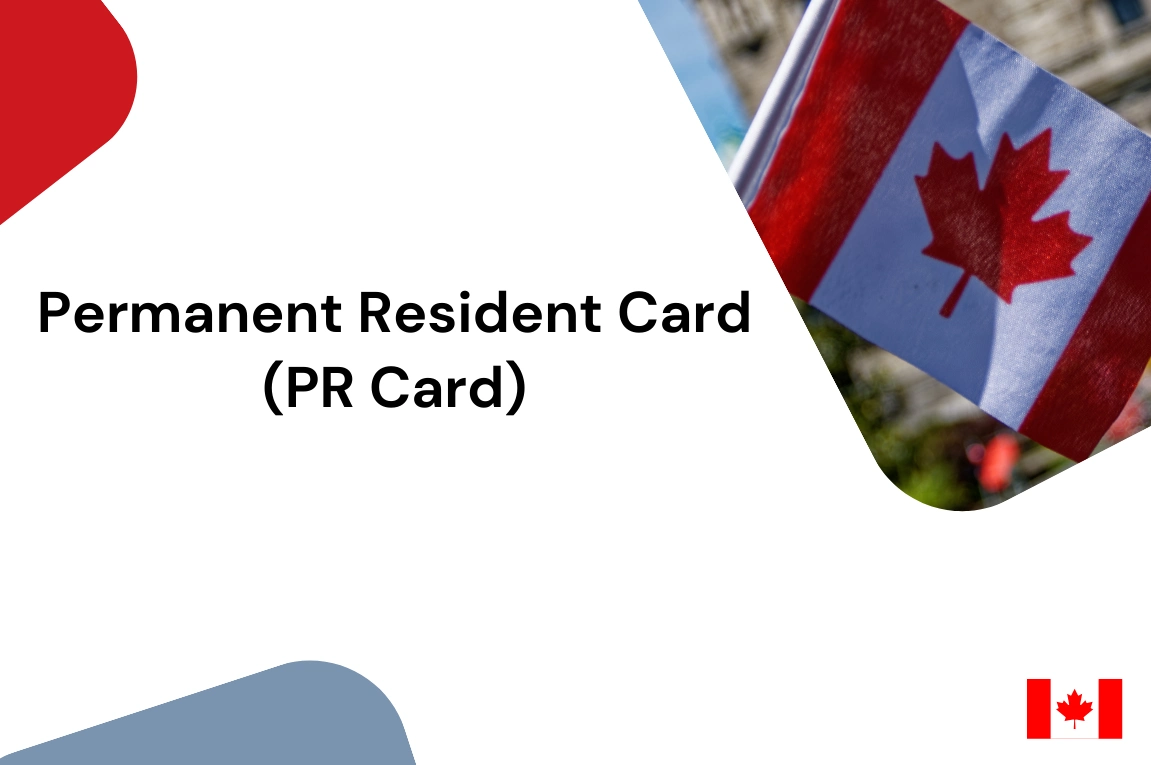A PR card is an official government-issued ID that proves you are a permanent resident of Canada and allows you to travel in and out of the country.
Getting permanent residency in Canada is a big achievement. It means safety, stability, and a new chapter in life. But to truly enjoy these benefits, there’s one small card that plays a huge role: the Canada PR card.
This card is more than just plastic. It’s proof of your status as a permanent resident. It lets you re-enter Canada after traveling abroad, and it makes daily life smoother when you need to show your residency.
Many new residents feel nervous about how the PR card works:
- How do I apply?
- What if I lose it?
- Can I travel without it?
In this guide, we’ll walk through everything in plain language. No complex terms. No confusing steps. Just the information you need to stay confident and secure.
Looking for personalized, free guidance in your journey? Contact us Now
What is a Canada PR Card?
A Canada PR card is your official proof that you are a permanent resident. Think of it as your “key” to living and traveling freely in Canada.
It shows your name, photo, and PR status. When you travel outside Canada, you need it to get back in. Without it, returning home can become tricky, many newcomers realize this the hard way when they try to board a flight and can’t show their card.
Keeping it safe is key.
Why Is the PR Card Important?
The PR card is more than just an ID; it’s your proof that you have the right to live, work, and study in Canada. Without it, you may face challenges like:
- Traveling abroad: Airlines often won’t let you board without a PR card.
- Accessing government services: Some services require proof of permanent residence.
- Applying for jobs: Employers may ask to see your PR card.
Feeling stressed about losing or renewing your PR card? That’s completely normal. The good news is there are clear ways to solve these problems, and planning ahead makes life much easier.
Quick Tips:
- Keep your PR card in a safe place.
- Check the expiry date regularly.
- Always carry it when leaving and returning to Canada by air.
PR Card vs. Citizenship Card: Know the Difference
It’s easy to confuse a PR card with a citizenship card. Here’s a simple breakdown:
| Feature | PR Card | Citizenship Card |
|---|---|---|
| Who gets it | Permanent residents | Canadian citizens |
| Proof of status | Shows you are a PR | Shows you are a citizen |
| Travel use | Needed to return to Canada | Optional (passport is enough) |
| Rights | Live, work, study in Canada | All rights of a citizen, including voting |
| Expiry | Usually 5 years | No expiry |
In short, a PR card is for people who are not yet citizens but can live in Canada. A citizenship card is for those who are already Canadian citizens.
Tip: If citizenship is your goal, a PR card is the first step, but you can’t vote or get a Canadian passport until you become a citizen.
Traveling In and Out of Canada with a PR Card
Your PR card is crucial for travel. Here’s what you need to know:
- Air travel: Airlines usually require a valid PR card to let you board a flight back to Canada.
- Land or sea travel: You may be able to show other documents, but carrying your PR card is strongly recommended.
- Lost or expired card while abroad: You cannot board a flight to Canada. You’ll need a travel document from a Canadian consulate.
Who Can Apply for a Canada PR Card?
A PR card is for official permanent residents. You can apply if you:
- Have permanent resident status approved by the Canadian government
- Live in Canada and plan to stay (you must have spent at least 730 days in Canada within the last 5 years)
- Follow Canadian laws without any issues affecting your PR status
If you’re a new immigrant, your first PR card is usually sent automatically after landing. If it’s lost, stolen, or expired, you can apply for a replacement or renewal.
Getting Your First PR Card: Timing Matters

1. Within 180 Days of Receiving PR Status
- Your first PR card is processed automatically after you provide your Canadian mailing address.
- Most newcomers, like Express Entry or Provincial Nominee Program immigrants, follow this process.
- You usually get your card within a few weeks.

2. More Than 180 Days After Receiving PR Status
- You must apply manually using the official form.
- Provide supporting documents like your Confirmation of Permanent Residence (COPR) and passport.
- Processing may take a few weeks. You cannot board a flight to Canada without a valid PR card.
How to Apply for a PR Card
Case 1: New Permanent Residents Entering Canada Directly
Landing in Canada: Immigration officers confirm your PR status and give you your COPR.
Provide a Canadian mailing address for your PR card delivery.
Your PR card arrives in a few weeks. Keep your COPR safe; it’s important for your PR card and other official processes
Case 2: Temporary Residents Who Later Become Permanent Residents
- IRCC approves your PR application and sends your COPR.
- You must enter Canada as a permanent resident.
- Provide your Canadian mailing address for PR card delivery.
- Your PR card will be mailed automatically.
Tip: Even if you’ve lived in Canada for years as a temporary resident, you cannot get a PR card until you officially land as a permanent resident.
Required Documents for PR Card
First-Time PR Card (Newcomers):
- Confirmation of Permanent Residence (COPR)
- Passport or travel document
- Canadian mailing address
Renewal or Replacement:
- Completed PR Card application form (IMM 5444)
- Two recent photos meeting PR card requirements
- Current PR card (if renewing) or COPR (if lost/stolen)
- Passport or travel document
- Payment receipt (CAD $50)
- Optional: Letter explaining lost, stolen, or damaged card
Processing Time and Fees
- New PR card: ~36 days
- Renewal: ~31 days
- Fee: CAD $50
👥 A True Story
From Temporary Resident to PR
Meet Sara. She came to Canada as an international student three years ago. After two years of living and studying, she applied for permanent residency through Express Entry.
When she entered Canada as a permanent resident, she became eligible for her first PR card. Even though she had lived in Canada for a long time, she couldn’t get her PR card until she officially landed as a permanent resident.
Sara now keeps her PR card safe and tracks her days in Canada to maintain her permanent residency.
PR Card Renewal & Expiry
- Most PR cards are valid for 5 years.
- Renew if your card expires in less than 9 months or if it has already expired.
- Outside Canada with an expired card? You’ll need a Travel Document to return.
Lost, Stolen, or Damaged PR Card
Losing your PR card can feel stressful, but don’t panic.
Steps to replace it:
- Report lost or stolen card to IRCC.
- Fill out the replacement application form.
- Include proof of status (passport, photos, police report if stolen).
- Pay the fee online and send the application to IRCC.
Final Thoughts
Your Canada PR card is more than an ID; it’s your key to travel, work, and life in Canada.
Keep these in mind:
- Check your PR card’s expiry date
- Keep your COPR, passport, and PR card safe
- Plan ahead before traveling abroad
If you’re unsure about the process, our immigration experts can guide you step by step to make sure your application or renewal goes smoothly.
FAQs
Usually a few weeks, but processing times can vary depending on IRCC.
Not by air. Airlines usually require a valid PR card to board flights to Canada.
You can travel by land or sea, but it’s always safer to carry your PR card.
You must apply for a replacement PR card using the official form.
Apply for a replacement using the official form. If abroad, you’ll need a travel document from a Canadian consulate.
At least 730 days (2 years) within every 5-year period. These days don’t need to be consecutive.
Yes, but only after your permanent resident status is approved and you land in Canada.
CAD $50 for new, replacement, or renewal cards.


